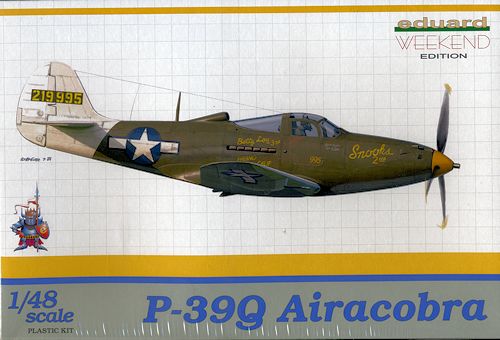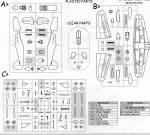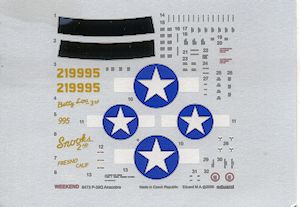
| KIT #: | 8473 |
| PRICE: | $9.95 on sale (19.95 SRP) |
| DECALS: | One option |
| REVIEWER: | Scott Van Aken |
| NOTES: | Weekend Edition, 2009 release |

| HISTORY |
The Bell P-39 Airacobra was one of the principal American fighter aircraft in service when the United States entered World War II. The P-39 was used with great success by the Soviet Air Force, which scored the highest number of kills per pilot attributed to any U.S. fighter type. Other major users of the type include the Free French, the Royal Air Force, the United States Army Air Forces, and Co-belligerent Italian Air Force.
Designed by Bell Aircraft, it had an innovative layout, with the engine installed in the center fuselage, behind the pilot, and driving a tractor propeller via a long shaft. It was also the first fighter fitted with a tricycle undercarriage. Although its mid-engine placement was innovative, the P-39 design was handicapped by the absence of an efficient turbo-supercharger, limiting it to low-altitude work. Together with the derivative P-63 Kingcobra, the P-39 was one of the most successful fixed-wing aircraft manufactured by Bell.
In September 1940, Britain ordered 386 P-39Ds (Model 14), with a 20 mm (.79 in) Hispano-Suiza HS.404 and six .303 in (7.7 mm), instead of a 37 mm (1.46 in) cannon and six 0.30 in (7.62 in) guns. The RAF eventually ordered a total of 675 P-39s. However, after the first Airacobras arrived at 601 Squadron RAF in September 1941, they were promptly recognized as having an inadequate rate of climb and performance at altitude for Western European conditions. Only 80 were adopted, all of them with 601 Squadron. Britain transferred about 200 P-39s to the Soviet Union.
Another 200 examples intended for the RAF were taken up by the USAAF after the attack on Pearl Harbor as the P-400, and were sent to the Fifth Air Force in Australia, for service in the South West Pacific Theatre.
By the time of the Pearl Harbor attack, nearly 600 P-39s had been built. When P-39 production ended in August 1944, Bell had built 9,558 Airacobras, of which 4,773 (mostly −39N and −39Q) were sent to the Soviet Union through the Lend-Lease program. There were numerous minor variations in engine, propeller, and armament, but no major structural changes in production types, excepting a few two-seat TP-39F and RP-39Q trainers. In addition, seven went to the U.S. Navy as radio-controlled drones.
| THE KIT |
 In
line with other Weekend edition kits, this one from Eduard is missing items that
were part of their Profipak kits. The major item not included is a large formed
nose weight which is essential in keeping this one on its nose gear. Also not in
the kit are masks for the canopy and wheels. You also only get one markings
option, but it is a nice one.
In
line with other Weekend edition kits, this one from Eduard is missing items that
were part of their Profipak kits. The major item not included is a large formed
nose weight which is essential in keeping this one on its nose gear. Also not in
the kit are masks for the canopy and wheels. You also only get one markings
option, but it is a nice one.
Eduard's plastic is identical to all their other P-39 kits. The nicely engraved plastic is still crisply done with minimal flash on only a few parts. If you know your P-39s, or have a quality reference such as the Mushroom Models Publications book on the Airacobra, you will be able to pretty much make any production P-39.
You get multiple spinners and prop blades, a drop tank or bomb, different exhausts, different wing guns and nose cannons as well as different wheels and different upper forward fuselage inserts. In fact, it is all those inserts that makes this a kit that one will need to build carefully to ensure that all those bits are properly installed. Eduard's interior is very nicely done with decals that can be placed over the instrument panels. There is quite a lot of interior detail and all you really need are a set of proper belts to really liven things up. The cockpit doors are made of clear plastic so one will need to mask the windows before painting. These are probably the worst fitting parts of the kit as they do not follow the fuselage contours very well if you want to model them closed. Going back a bit to the wheels, you are offered both flattened and perfectly round ones. Both will look nice and most will go for the flattened ones. The kit also includes the under wing cannon pods (not shown in parts guide), and you will need to open the appropriate holes in the wings for them, something the instructions fail to show.
 Instructions
are well drawn and provide Gunze color references. Markings are for the box art
plane from the 71 TRS/82 TRG in 1944. It is in OD over neutral grey and has the
white tail and white leading edge wing markings typical of the New Guinea
theater of operations. The spinner on this one is yellow. Those wanting different markings will have no problem finding
them from a variety of sources. The kit decals, however, are superbly done and
as good as anything you will find in the aftermarket. I did notice that the
sheet has no blue surround to the insignia while the box art does. Also note
that the blue in the scan is actually lighter than what is on the sheet so the
sheet is the correct shade. Of course, there are also
photo etch frets and masks available for this kit, but that sort of defeats the
purpose of getting the less expensive Weekend Edition.
Instructions
are well drawn and provide Gunze color references. Markings are for the box art
plane from the 71 TRS/82 TRG in 1944. It is in OD over neutral grey and has the
white tail and white leading edge wing markings typical of the New Guinea
theater of operations. The spinner on this one is yellow. Those wanting different markings will have no problem finding
them from a variety of sources. The kit decals, however, are superbly done and
as good as anything you will find in the aftermarket. I did notice that the
sheet has no blue surround to the insignia while the box art does. Also note
that the blue in the scan is actually lighter than what is on the sheet so the
sheet is the correct shade. Of course, there are also
photo etch frets and masks available for this kit, but that sort of defeats the
purpose of getting the less expensive Weekend Edition.
| CONCLUSIONS |
Many say that this is the kit with which Eduard entered the 'big time', and I would have to agree with that. It fits well and has as much detail as anyone could want straight from the box. It is also available at a very decent price, and unlike other weekend edition kits where the lack of photo-etch reduces the number of versions or options, this one was an earlier mold that did not rely on that. If you like P-39s, you should seriously consider picking up several.
| REFERENCES |
http://en.wikipedia.org/wiki/P-39
2013
Thanks to me for picking this one up.
If you would like your product reviewed fairly and fairly quickly, please contact the editor or see other details in the Note to Contributors.